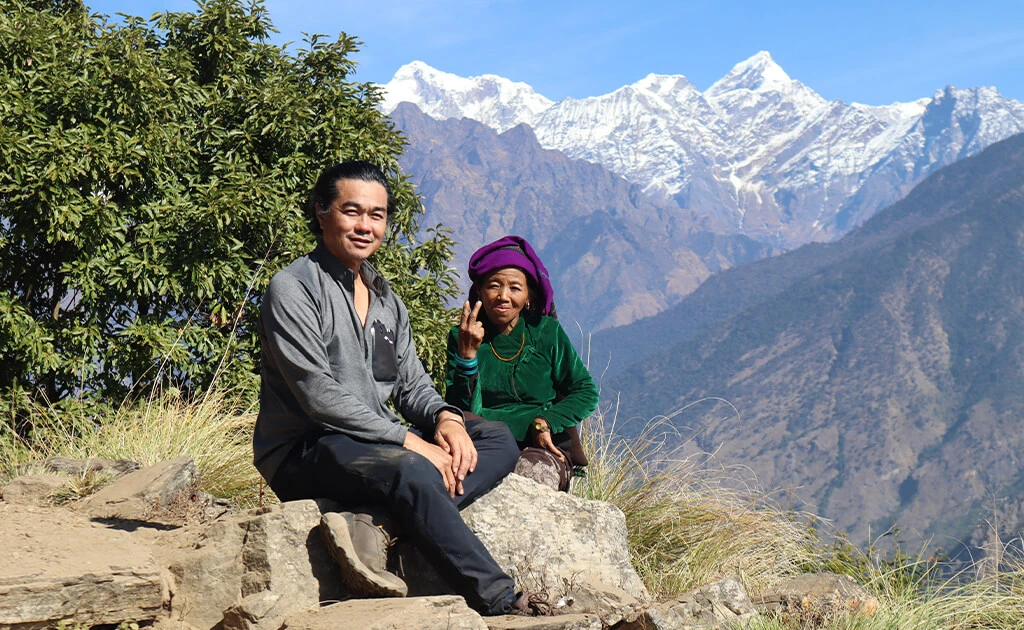A Typical Day on the Manaslu Circuit Trek
This trek is both challenging and rewarding, featuring lengthy days of hiking, often at high altitudes. To help you acclimate and maintain your health and fitness, we’ve included a couple of rest days in the itinerary. Each day of the trek is a new adventure, filled with breathtaking sights and opportunities for photography. Here’s a glimpse of what a typical day looks like: The day begins early to maximise daylight hours. After a night’s rest in a cosy teahouse, you’ll start with breakfast at the lodge, fueling up for the day ahead. The trail will lead you through diverse landscapes – from encountering mules on the path to traversing rocky terrains, crossing rivers, and wandering through forests, all while marvelling at the majestic mountains. The region’s proximity to Tibet means you’ll witness the influence of Tibetan culture, evident in the fluttering prayer flags and various Buddhist artefacts along the way.
Dinner is served in the same teahouse where you’ll be staying. This is a wonderful time to bond with your fellow trekkers and guides. During dinner, your guide will brief you on the next day’s route, highlight any special points of interest, and answer any questions you might have. It’s customary to order your breakfast the night before, ensuring it’s ready when you wake up early the next morning, eager to embark on another day of adventure.
What to Expect in a Teahouse in Manaslu
The teahouse is like a simple guest house on the mountain trails. It provides trekkers with accommodation, meals, and a common place to socialise. Overall, these provide basic accommodation in twin rooms or dormitories. Toilets and bathrooms are shared, with either a Western-style toilet or a squat-style toilet. Showers normally only have cold water; you will be expected to pay for it in those with hot water. The sleeping rooms consist of beds, blankets, and not much else. Bringing your sleeping bag is always recommended. There are no ‘single rooms’ unless it is off-season, and you are lucky. Sharing a room is perfectly normal. There is no heating in the sleeping rooms. Some stoves usually warm the dining area. Light is provided by solar power, although most teahouses charge your gadgets, for which you have to pay. Breakfast and dinner are taken in the teahouses at communal tables where you can discuss the day’s journey with others. Some menus offer a variety of food. Boiled water is usually available, rather than in plastic bottles, which hurts the environment. There is a small charge for boiled water. If you bring water purification tablets, that will be the best option.
What kind of Food is available on the Manaslu Trek?
As this is a restricted area, even no more crowded than the everest region trek, teahouse menus are not as extensive as on some older, more established, and busy trekking routes. But your expectations may differ from reality. Menus are limited.
Breakfast at your overnight teahouse on the Manaslu Trek:
- Spicy Nepali omlet with chilli, onion, and tomatoes
- Toast or Tibetan bread with jam or honey
- Nepali spiced tea, salty Tibetan tea (in some settlements), or coffee (if available)
- Lunch at a small teahouse on the trail
- Dal bhat (rice, curry, lentils) or noodles
- Nepali tea or a soft drink
- Dinner at your overnight teahouse on the Manaslu Trek:
- A variety of soups, i.e., garlic soup, mushroom soup, veg soup
- Tibetan bread (when available)
- Momos and chowmein
- Fried noodles with vegetables
- Dal Bhat
- Fried rice
- Rice pudding
- Soft drinks and beer, Nepali tea
Are There Hot Showers on this Trek?
If hot water is available for a shower, you will be expected to pay around $3 to $5 per shower, depending on location. This is because hot water is usually generated by gas cylinders, solar, or fire. which must be carried up the mountain at some effort and expense. We recommend you conserve energy (and your money) and not shower too often. The effort to take off and put on clothes might be too much in cooler weather.
How High Will I Go on the Manaslu Trek?
The day you visit the Tibetan border, you will reach 5,000m/ 16,404ft, and at the Larky La Pass, you will be at 5,106m, the highest point on the trek. Manaslu Circuit is a challenging trek; we do not recommend it for inexperienced trekkers. You should be in very good physical shape to tackle this trek. The high altitude makes it challenging for everyone, but it might be a real struggle for those who are unfit or have some medical problems. But if you are fit, this is a wonderful trek and will push you to achieve more.
Altitude Sickness
Going above 3,000 m-3,500 m can cause some people to feel some effects of altitude. As you can see, this trek goes up to over 5,000m. But there is plenty of time on the trail and the two acclimatisation days for our bodies to adjust to the height. All Iconic Holiday Nepal guides are well-experienced (with an average of 7 years of trekking experience each) and know what to look for and do if anyone is feeling unwell. Please tell your guide if you feel unwell at any stage of the trek.
Charging Your Equipment on the Manaslu Trail
Many teahouses on this trek have electricity or solar-powered electricity. However, as almost everyone carries some chargeable device these days, the teahouse owner will pass the cost on to the visitor. Generally, teahouses will charge you $2 to $3 for your phone or camera. This can become expensive as there are so many wonderful things to photograph. We recommend you carry a power bank or a small solar charger to avoid paying too much. Some great solar chargers clip onto your day pack.
